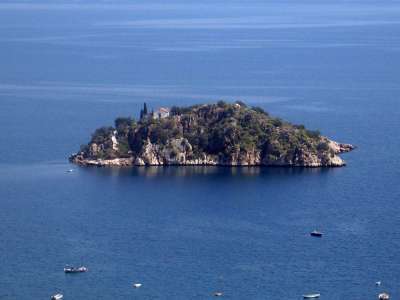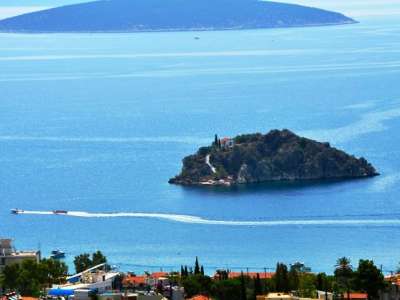LOCATION
WELCOME TO TOLO
all kinds of water sports. Modern tourist center of the archaeological site – Ancient Asini, Epidaurus, Tiryns, Mycenae, Argos, Nafplion offers the
opportunity to visit with local buses, guided tours, cars, motorbikes.

It is the large island opposite Tolo, about 1.6 square kilometers. In Romvi are damaged walls and ruins of old houses. Old was the shipyard for fishermen.

Island with low scrub vegetation. At the top there is a chapel dedicated to the Virgin Mary. Renovated, according to an inscription in the temple by Cretan refugees in 1869.

On top of Koronisi stands the church of the twelve Apostles, being one of the most popular spots in Tolo. The church view from the cafes and bars of Tolo is magnificent.
In Barbunas hill you can see the famous caves where they say that it was hidden the king of Assini, when the enemies chased him. It is said that as the soldiers were looking for him, an officer watching prevented one soldier to look for him in the caves assumming thet if the king went to that way the webs of the spiders would have gone. So the spiders saved the king!
Or otherwise known as the 999 steps! If you are an extreme person and the winds don’t favour for kite surf, you can take the steps up to Palamidi and keep yourself in excellent shape at the same time. And, to be frank, the stairs are only 857!To be more serious, the idea is not so extreme, considering that you can make resting stops along the way, seating on the larger steps and having the unique view of Nafplio and of the sea as a reward. There is, however, the option that the majority of the visitors prefer; get inside your car and drive to the east side of the castle. Well done! You have just arrived to one of the most important and best-preserved castles in Greece, an exquisite example of Venetian architecture of the 18th century. The hill at which the castle is located was named after Palamidis, the hero of Homer’s Epics. It is said that, in 1686, the Venetian Commander-in-Chief Morosini envisioned the construction of the castle, whose architectural design was undertaken by governor Grimani. In 1715, just one year after its completion, it was occupied by the Turks and just one century later it finally came to the possession of the Greeks.
Castello dello Soglio was the first name of the Venetian castle, which along with Palamidi, is considered one of the landmarks of Nafplio. Nevertheless, the name that finally prevailed is Bourtzi, which in Turkish means « Island – Fort ».With the Venetian «castle of the throne» there is always a dilemma for you: Is it better to gaze it from a distance- like a postcard that never fades- or to wander in its microcosm and smell strong smells of history? What is certain is that just looking at it is not enough; just like everybody else , you will probably want to know its history. Bourtzi was built on the islet of St. Theodoroi in1473 by the Italian engineer Gabelo and that is why its first name is Italian. Moreover, if you have heard people refer to Nafplio as «the chain harbour» (Porto Cadena ), this is because there was, indeed, a mobile chain which connected Acronafplia with Bourtzi and whose purpose was to protect the harbour and the city from sea invaders. As years passed by, the Venetian castle was used in a variety of ways. Being, initially, the first prison of Kolokotronis (best-known hero of the Greek revolution against the Turks) and the residence of the executioners of Palamidi, it later offered housing to the Greek government twice. During the 30s it operated as a centre of the Greek national tourist organisation and from 1960 to 1970 as a luxury hotel and restaurant.
Akronafplia is the imposing rocky peninsula that once was the Acropolis of Nafplio. The Turks used to call it “Its-Kale” that means “inside the fortress”. How to get there
You can approach the castle and admire the unique view with many ways: You can go east at Staikopoulos Park and from the Arvanitias square, or you can walk through the “dromoskala” of the Catholic Church and the gate of the Castle of Toroni.
With a capacity of 20,000 seats approximately, it counts among the largest ancient theatres in Greece. Nestling in the southeastern side of the castle hill, so as to be linked to the agora, it overlooked the ancient city and was visible from the Argolic gulf. Preexisting small sanctuaries interspersed on the same spot, including those of the Dioskouroi and Zeus Eubouleus, remained untouched during construction of the monument. Built during the Hellenistic period, in the early third century BC, it replaced the oldest theatre of the town, which lied about 100m to the south and was built in the fifth century BC, probably in order to host music and drama contests during the Panhellenic Nemean games, which were then transferred definitively to the town of Argos from the sanctuary of Zeus in Nemea; almost simultaneously, the Heraian games were also transferred to Argos. According to evidence, the oldest Nemean competition taking place in the theatre of Argos in 205 BC involved guitar players and singers. The monument also hosted political conferences, such as the regular Sessions of the Achaian Sympoliteia (League) during the second century BC.
In a canyon, in 340 BC, an Argos architect Polykleitos the Younger, built, according to Pausanias, the theatre of Epidaurus. Among all the ancient theatres, Epidaurus theatre is the most beautiful and best preserved. Destined for the fun of the patients of Asklipieio, it had a capacity of 13,000 spectators. It was divided into two parts: A 21-rows of seats part, aimed for the citizens and a 34-rows of seats part aimed for the priests and rulers. The superb acoustics as well as the very well preserved construction, contributed to the creation of Epidaurus Festival S.A., an institution that contributed to the cultural revival of the theatre. Great actors have acted at such as Alexis Minotis, Thanos Kotsopoulos, Anna Synodinou, Thanasis Vengos and the famous Greek soprano Maria Kallas.
Reaching the port, Hydra island looks glamorous like an art-paint, with grey, white and blue colours above the blue of the sea, an exemplar of architectonics and aesthetics. The town of Hydra island, which is the centre of the whole island, is built amphitheatrically around the port, combining nature and architecture. From your very first visit, a magic feeling surrounds you. Perhaps it’s in the unique architecture and graphic scenes throughout the Island, or perhaps it’s in its long history and rich heritage, or even – a fusion of all. A stroll through the town’s picturesque cobble stone streets, will convince you of its uniqueness. The visitor, coming for the first time, is impressed from the view of the tall buildings and Manors, which exist in the port. Right and left from the entrance of the port, there are the Parapets with the Canons, which protected the town. Today, the port of Hydra is filled with little and big yachts, boats and cruisers. You can walk to the port, the heart of the town, take a stroll at the tourist shops, admire the old Manors and visit the Museum of Hydra island.


